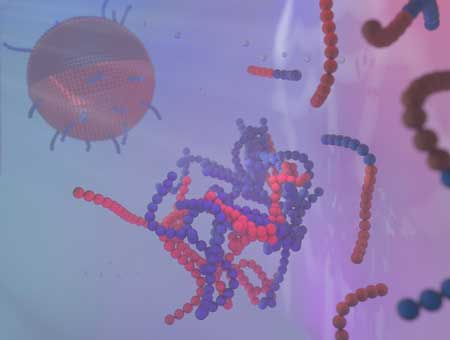| Feb 19, 2019 | |
Nanodroplets are the key to controlling membrane formation(Nanowerk News) The creation of membranes is of enormous importance in biology, but also in many chemical applications developed by humans. These membranes are shaped spontaneously when soap-like molecules in water join together. |
|
| Researchers at Eindhoven University of Technology now have a clear picture of the entire process. Membrane formation turns out to start with nano-droplets in the water with a higher concentration of soap-like molecules. If you can control those nanodroplets, you can control shape, thickness and size of the membranes. This is of great importance for, among other things, the development of new nanomedicines. | |
| The results are published in Nature Chemistry ("Liquid-liquid phase separation during amphiphilic self-assembly"). | |
 |
|
| Artist impression of amphiphilic self-assembly from dissolved molecules (right, foreground), the formation of a nano-droplet (middle), into a liposome (left, far back). (Image: Giorgio Gasco) | |
| Biological membranes, and man-made variants, consist of amphiphilic molecules, of which soap is an example. These molecules have a head that bonds with water, but a tail that turns away from water. You can imagine that a group of such molecules in water, preferably puts the tails together, and sticks the heads out, towards the water. | |
| Similar processes also dominate the creation of membranes. Often they are spherical, like liposomes, so you can, for example, put a medicine in it. And also the ultimate membrane, the cell wall, is constructed in a similar way. | |
How nano-droplets self-assemble |
|
| Until now, the formation of 'micelles' was considered to be the first step in membrane formation. A micelle is an extremely small spherical structure (about 100 nanometers) of amphiphilic molecules - all with the tails inwards and the heads outwards. | |
| However, researchers at Eindhoven University of Technology discovered a different beginning: the formation of nano-droplets in water with a higher concentration of amphiphilic molecules. At the interface of that drop, the amphiphilic molecules, as it were, take each others’ hands: first they form spheres, which then change into cylinders or plates, and then a closed membrane is created that encloses the nano-droplet. With this so-called 'self-assembly' process, the droplet has become a liposome. | |
 |
|
| Schematic of the self-assembly from nano-droplets (left), intermediated by micelles and cylinders and plates (middle), into a liposome (right). (Image: Alessandro Ianiro) | |
Video captures selfassembly with electron microscope |
|
| The research team predicted this outcome on the basis of a mathematical model and computer simulations, and then confirmed it with a very special form of electron microscopy. With Liquid-Phase Electron Microscopy they could make videos of the formation of liposomes. Because regular amphiphilic molecules are too small for even this form of microscopy to see, the researchers used much larger molecules that work in the same way (block copolymers). | |
Applications |
|
| According to the researchers, their new insights are fundamental to better control the self-assembly of membranes. They expect to see the knowledge reflected in a wide range of applications. Professor Nico Sommerdijk, one of the researchers, is thinking of, among other things, nanomedicine, including better ways to deliver cancer medicines to the right place in the body, by encapsulating them in liposomes. |
| Source: Eindhoven University of Technology | |
|
Subscribe to a free copy of one of our daily Nanowerk Newsletter Email Digests with a compilation of all of the day's news. |
